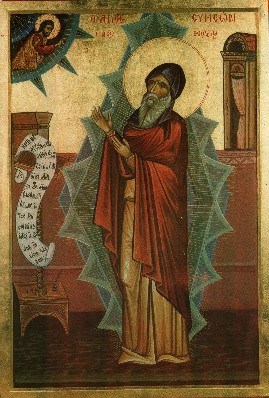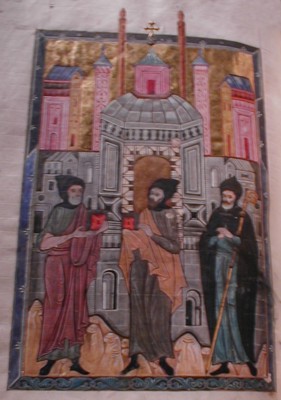
Anthony the Great was a Christian monk from Egypt, revered since his death as a saint. He is distinguished from other saints named Anthony, such as Anthony of Padua, by various epithets: Anthony of Egypt, Anthony the Abbot, Anthony of the Desert, Anthony the Anchorite, Anthony the Hermit, and Anthony of Thebes. For his importance among the Desert Fathers and to all later Christian monasticism, he is also known as the Father of All Monks. His feast day is celebrated on 17 January among the Eastern Orthodox and Catholic churches and on Tobi 22 in the Coptic calendar.

Gennadius II was a Byzantine Greek philosopher and theologian, and Ecumenical Patriarch of Constantinople from 1454 to 1464. He was a strong advocate for the use of Aristotelian philosophy in the Orthodox Church.

Proclus was the archbishop of Constantinople from 434 until his death. Renowned for his homiletic abilities, Proclus played a central role in the Nestorian controversy. His contributions to the theology of the developing cult of the Virgin Mary place him among the early and foremost Marian theologians. He is venerated as a saint in the Catholic Church, the Eastern Catholic Churches, the Eastern Orthodox Church, and Oriental Orthodoxy.
The Philokalia is "a collection of texts written between the 4th and 15th centuries by spiritual masters" of the mystical hesychast tradition of the Eastern Orthodox Church. They were originally written for the guidance and instruction of monks in "the practice of the contemplative life". The collection was compiled in the 18th century by Nicodemus the Hagiorite and Macarius of Corinth based on the codices 472, 605, 476, 628 and 629 from the library of the monastery of Vatopedi, Mount Athos.

John IV, also known as John Nesteutes, was the 33rd bishop or Patriarch of Constantinople. He was the first to assume the title Ecumenical Patriarch. He is regarded as a saint by the Eastern Orthodox Church which holds a feast on September 2.

Ammon, Amun, Ammonas, Amoun (Ἀμοῦν), or Ammonius the Hermit was a 4th-century Christian ascetic and the founder of one of the most celebrated monastic communities in Egypt. He was subsequently declared a saint. He was one of the most venerated ascetics of the Nitrian Desert, and Athanasius of Alexandria mentions him in his life of Anthony the Great.

Symeon the New Theologian was an Eastern Orthodox monk and poet who was the last of three saints canonized by the Eastern Orthodox Church and given the title of "Theologian". "Theologian" was not applied to Symeon in the modern academic sense of theological study; the title was designed only to recognize someone who spoke from personal experience of the vision of God. One of his principal teachings was that humans could and should experience theoria.

Evagrius Ponticus, also called Evagrius the Solitary, was a Christian monk and ascetic from Heraclea, a city on the coast of Bithynia in Asia Minor. One of the most influential theologians in the late fourth-century church, he was well known as a thinker, polished speaker, and gifted writer. He left a promising ecclesiastical career in Constantinople and traveled to Jerusalem, where in 383 AD he became a monk at the monastery of Rufinus and Melania the Elder. He then went to Egypt and spent the remaining years of his life in Nitria and Kellia, marked by years of asceticism and writing. He was a disciple of several influential contemporary church leaders, including Basil of Caesarea, Gregory of Nazianzus, and Macarius of Egypt. He was a teacher of others, including John Cassian and Palladius of Galatia.

Saint Nilus the Elder of Sinai was one of the many disciples and stalwart defenders of St. John Chrysostom.
Hesychius of Sinai was a hieromonk of Saint Catherine's Monastery on Mount Sinai, and an ascetic author of the Byzantine period in literature.

Isidore of Pelusium was born in Egypt to a prominent Alexandrian family. He became an ascetic, and moved to a mountain near the city of Pelusium, in the tradition of the Desert Fathers.
A patristic anthology, commonly called a florilegium, is a systematic collections of excerpts from the works of the Church Fathers and other ecclesiastical writers of the early period, compiled with a view to serve dogmatic or ethical purposes. These encyclopedic compilations are a characteristic product of the later Byzantine theological school, and form a very considerable branch of the extensive literature of the Greek Catenæ. They frequently embody the only remains of some patristic writings.
John Moschus, was a Byzantine monk and ascetical writer.
Leontius of Byzantium was a Byzantine Christian monk and the author of an influential series of theological writings on sixth-century Christological controversies. Though the details of his life are scarce, he is considered by some a groundbreaking innovator in Christian theological reflection for having introduced Aristotelian definitions into theology.
Orientius was a Christian Latin poet of the fifth century.

Saint Simeon Stylites the Younger, also known as Simeon of the Admirable Mountain, is a saint in the Catholic Church and Eastern Orthodox Church.
Andrew Chrysoberges, also called Andrew of Rhodes or Andrew of Colossus, was a Greek Dominican prelate and theologian.
Marius Mercator was a Latin Christian ecclesiastical writer best known for his advocacy of Augustinian theology during the Pelagian controversy.

Joseph the Hymnographer was a Greek monk of the ninth century. He is one of the greatest liturgical poets and hymnographers of the Eastern Orthodox Church. He is also known for his confession of the Orthodox Faith in opposition to Iconoclasm.
Marcus Diadochus was a Christian writer of the fourth century.











